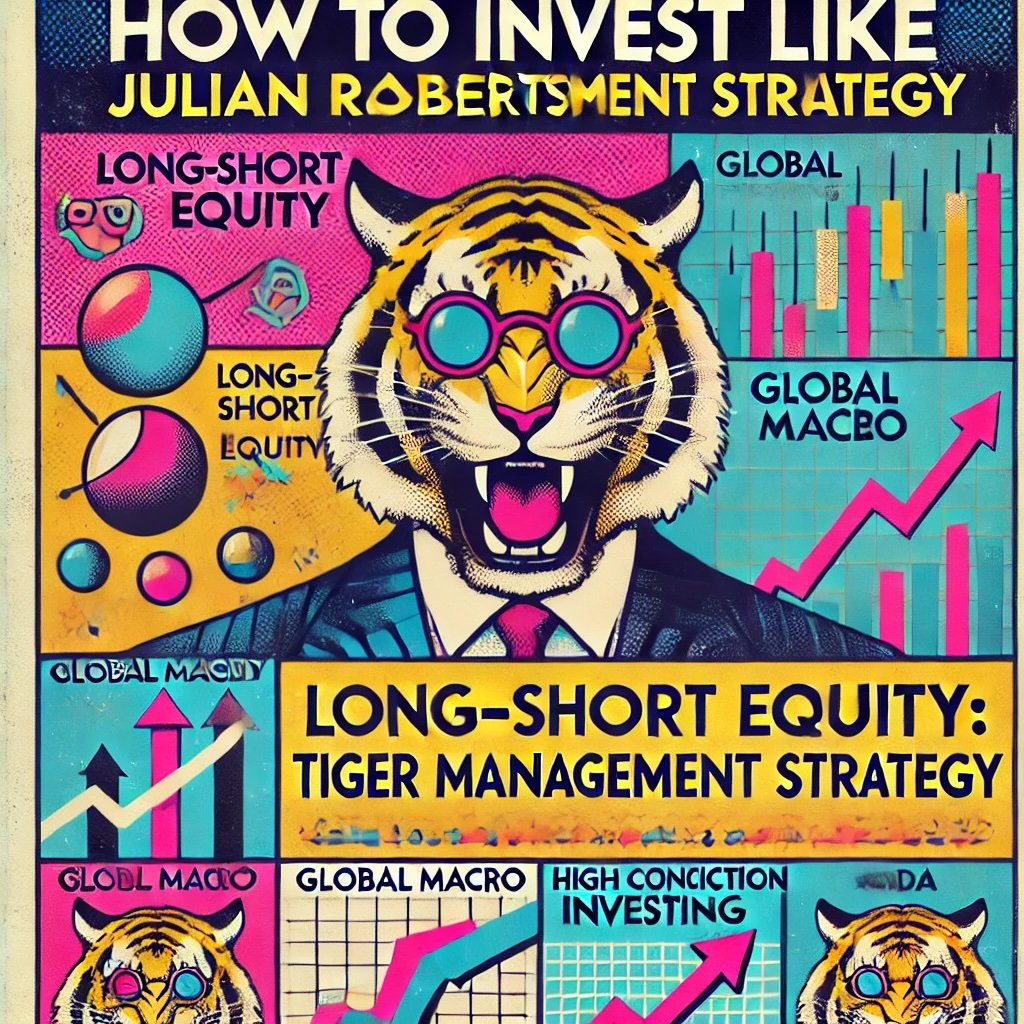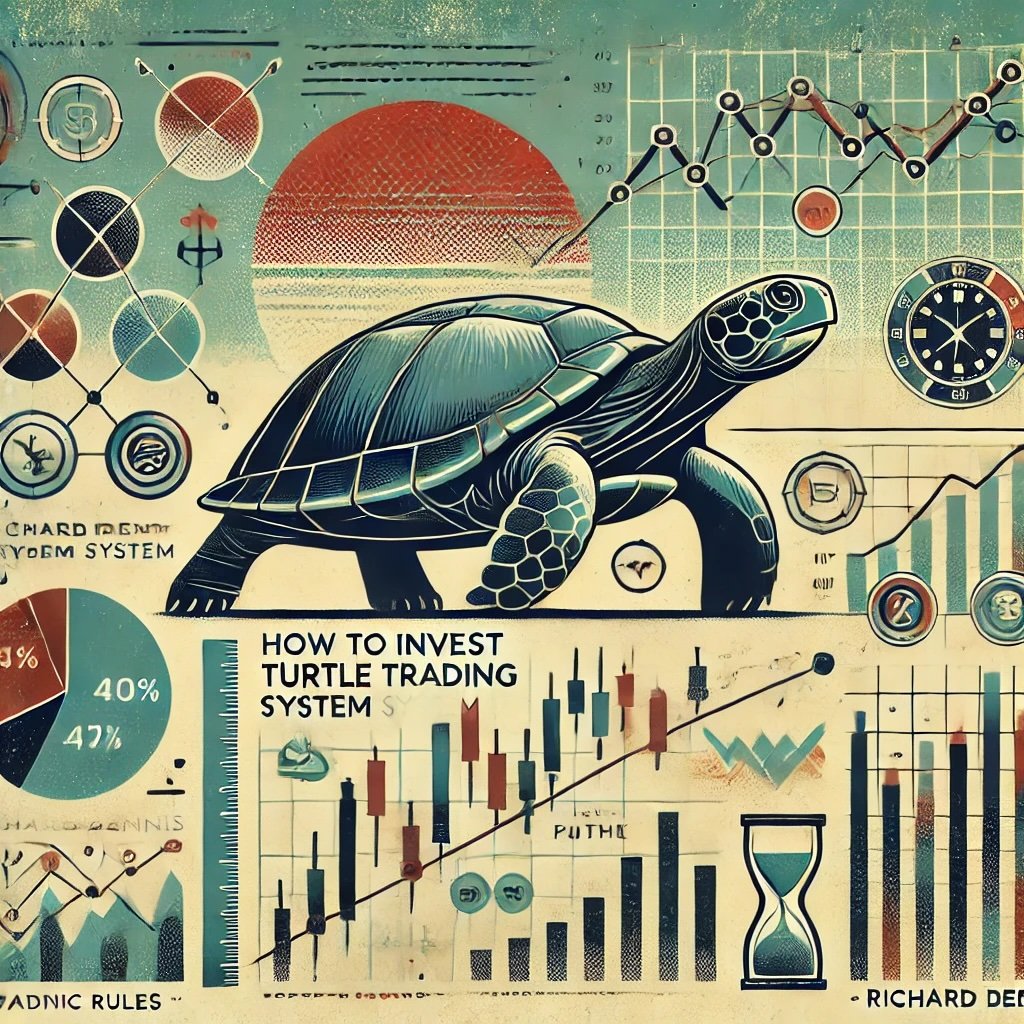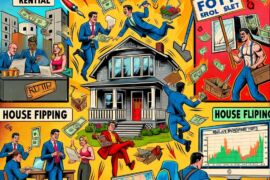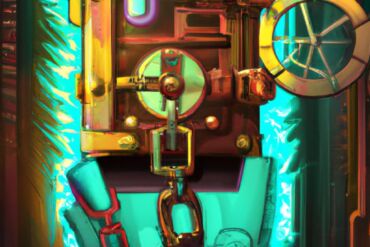Investing can often feel like navigating a complex maze, filled with twists, turns, and dead ends. Yet, some investors not only navigate this maze successfully but also redefine the path for others. One such legendary figure is Julian Robertson, the founder of Tiger Management. Born in 1932 in Salisbury, North Carolina, Robertson didn’t just participate in the world of finance—he transformed it. His innovative strategies and keen eye for talent have left an indelible mark on the investment landscape.
source: CNBC Television on YouTube
This guide aims to delve deep into Robertson’s investment philosophy and the strategies that made Tiger Management a powerhouse in the hedge fund industry. We’ll explore the key principles that underpinned his success, including the long/short equity strategy, meticulous macroeconomic analysis, an unwavering commitment to thorough research, and the cultivation of talent through mentorship.

Whether you’re an aspiring investor looking to learn from the best or a seasoned professional seeking to refine your strategies, this article will provide valuable insights into how you can apply the Tiger Management approach to your own investment practices. So, grab a comfortable seat and prepare to embark on a journey through the mind of one of the greatest investors of our time.

The Long/Short Equity Strategy
What Is Long/Short Equity?
At the core of Julian Robertson’s investment success lies the long/short equity strategy. But what exactly does this entail? In essence, it’s an investment approach that involves taking long positions in stocks that are expected to appreciate in value and short positions in stocks that are anticipated to decline. This strategy allows investors to potentially profit from both rising and falling markets, effectively hedging against market volatility.
Understanding the Mechanics:
- Long Positions: Buying stocks outright with the expectation that their price will increase over time. This is the traditional method of investing.
- Short Positions: Borrowing stocks and selling them on the open market with the intention of buying them back later at a lower price. If the stock’s price falls, the investor profits from the difference.
Advantages of the Long/Short Strategy:
- Risk Mitigation: By balancing long and short positions, investors can reduce exposure to market-wide movements.
- Enhanced Returns: The ability to capitalize on declining stocks can boost overall portfolio performance.
- Market Neutrality: Investors can aim for returns independent of general market trends.

Identifying Opportunities
Julian Robertson was renowned for his ability to identify undervalued and overvalued stocks through rigorous fundamental analysis. His approach wasn’t about following market hype or chasing trends; it was about digging deep into a company’s financial health, management team, and industry position.
Key Components of Robertson’s Analysis:
- Financial Health:
- Balance Sheets: Examining assets, liabilities, and shareholder equity to assess stability.
- Income Statements: Analyzing revenue streams, expenses, and profitability.
- Cash Flow Statements: Understanding liquidity and cash generation capabilities.
- Management Quality:
- Track Record: Evaluating past performance and decision-making.
- Leadership Style: Assessing the ability to inspire and manage teams effectively.
- Vision and Strategy: Understanding long-term goals and plans for achieving them.
- Industry Position:
- Market Share: Determining the company’s standing relative to competitors.
- Competitive Advantage: Identifying unique strengths or proprietary technologies.
- Regulatory Environment: Considering how laws and regulations may impact operations.
- Economic Moats:
- Brand Strength: Recognizing the value of strong brand recognition and loyalty.
- Cost Advantages: Identifying efficiencies that allow for lower production costs.
- Network Effects: Understanding how the value of a product increases with user adoption.
By meticulously analyzing these factors, Robertson could pinpoint stocks that the market had mispriced, setting the stage for successful long or short positions.
Case Study: A Successful Long/Short Trade
To illustrate the effectiveness of Robertson’s strategy, let’s delve into a real-world example from the late 1990s during the dot-com bubble.
The Context:
- Market Sentiment: The late 1990s saw an unprecedented surge in technology stocks, with investors pouring money into internet companies regardless of their profitability or business models.
- Overvaluation: Many of these companies had little to no earnings, yet their stock prices soared based on speculative future growth.
- Undervaluation: Traditional companies with solid fundamentals were often overlooked in favor of flashy tech startups.
Robertson’s Strategy:
- Shorting Overvalued Tech Stocks:
- Identification: Recognized that many internet companies lacked sustainable business models.
- Analysis: Examined financials that revealed unsustainable burn rates and negligible revenues.
- Action: Took short positions against these overvalued tech stocks, anticipating a market correction.
- Investing in Undervalued Traditional Companies:
- Identification: Found companies in sectors like manufacturing, consumer goods, and finance that were trading below their intrinsic value.
- Analysis: Confirmed strong financial health, stable earnings, and competent management.
- Action: Established long positions in these undervalued stocks.
Outcome:
- Dot-Com Crash: In 2000, the bubble burst, and tech stocks plummeted.
- Profit from Shorts: The short positions in overvalued tech companies yielded substantial returns as their stock prices collapsed.
- Stability from Longs: The investments in undervalued traditional companies provided a buffer against market volatility and contributed to overall portfolio gains.
Key Takeaways:
- Contrarian Approach: Robertson’s willingness to go against market sentiment allowed him to capitalize on mispricings.
- Risk Management: Balancing long and short positions mitigated risk and provided multiple avenues for profit.
- Fundamental Focus: Relying on in-depth analysis rather than market hype proved to be a successful strategy.

Macroeconomic Analysis
Global Perspective
Julian Robertson understood that no company operates in a vacuum. Macroeconomic factors—such as interest rates, inflation, currency fluctuations, and geopolitical events—can significantly impact investment outcomes. By incorporating a global perspective into his investment process, Robertson could anticipate market shifts and adjust his strategies accordingly.
Key Macroeconomic Factors Considered:
- Interest Rates:
- Impact on Borrowing Costs: Higher interest rates can increase expenses for companies with significant debt.
- Consumer Spending: Changes in rates affect consumer loans, influencing spending patterns.
- Inflation:
- Cost of Goods Sold: Rising inflation can increase production costs, squeezing profit margins.
- Pricing Power: Companies with strong brands may pass costs to consumers, maintaining profitability.
- Currency Fluctuations:
- Exporters vs. Importers: Currency strength affects the competitiveness of companies in global markets.
- Foreign Earnings: Multinational companies’ earnings can be impacted when converting foreign profits back to the home currency.
- Geopolitical Events:
- Regulatory Changes: New laws or tariffs can alter the business environment.
- Political Stability: Instability can disrupt markets and supply chains.
Sector Analysis
By combining macroeconomic insights with sector-specific analysis, Robertson could identify industries poised for growth or decline. This approach enabled him to allocate resources more effectively and enhance portfolio performance.
Process of Sector Analysis:
- Economic Indicators:
- GDP Growth Rates: Sectors like construction and manufacturing may benefit from economic expansion.
- Consumer Confidence: High confidence levels can boost retail and discretionary spending sectors.
- Technological Advancements:
- Innovation Trends: Identifying sectors undergoing technological disruption or advancement.
- R&D Spending: Industries investing heavily in research may offer growth opportunities.
- Regulatory Environment:
- Deregulation: Sectors like finance may benefit from relaxed regulations.
- Environmental Policies: Energy sectors may be impacted by environmental regulations.
- Demographic Shifts:
- Aging Populations: Healthcare and pharmaceutical sectors may see increased demand.
- Urbanization: Infrastructure and real estate sectors may experience growth.
How Macroeconomic Views Influenced Portfolio Decisions
Case Study: Navigating the Asian Financial Crisis
Background:
- The Crisis: In 1997, several Asian economies faced a financial meltdown due to excessive borrowing, currency devaluation, and loss of investor confidence.
- Global Impact: The crisis led to significant volatility in global financial markets.
Robertson’s Analysis:
- Early Warning Signs:
- Debt Levels: Noticed unsustainable levels of corporate and government debt in affected countries.
- Currency Pegs: Recognized vulnerabilities in fixed exchange rate systems.
- Economic Indicators: Detected slowdowns in export growth and increasing trade deficits.
- Strategic Adjustments:
- Reduced Exposure: Sold positions in companies heavily reliant on Asian markets.
- Short Positions: Shorted currencies like the Thai baht and Malaysian ringgit, anticipating devaluation.
- Hedging: Used derivatives to hedge against potential losses from market volatility.
Outcome:
- Minimized Losses: By adjusting his portfolio before the crisis fully unfolded, Robertson mitigated potential losses.
- Profitable Shorts: Gains from short positions on devalued currencies and stocks offset other market declines.
- Strengthened Reputation: Demonstrated the effectiveness of incorporating macroeconomic analysis into investment strategies.
Key Takeaways:
- Proactive Approach: Anticipating macroeconomic shifts allows for timely portfolio adjustments.
- Comprehensive Analysis: Combining global economic indicators with sector and company analysis enhances decision-making.
- Risk Management: Diversifying investments geographically and across sectors can protect against localized downturns.

Emphasis on Thorough Research
Deep Fundamental Analysis
For Julian Robertson, thorough research wasn’t just a step in the investment process—it was the foundation. He believed that a deep understanding of a company’s fundamentals was essential for making informed investment decisions.
Components of Fundamental Analysis:
- Financial Statements:
- Earnings Quality: Assessing the sustainability and reliability of earnings.
- Debt Ratios: Evaluating leverage and the ability to meet financial obligations.
- Liquidity Ratios: Understanding the company’s ability to cover short-term liabilities.
- Competitive Analysis:
- Porter’s Five Forces: Analyzing competitive rivalry, the threat of new entrants, supplier power, buyer power, and the threat of substitutes.
- SWOT Analysis: Identifying strengths, weaknesses, opportunities, and threats.
- Management Evaluation:
- Corporate Governance: Assessing board composition and shareholder rights.
- Succession Planning: Ensuring continuity in leadership and strategy.
- Market Trends:
- Consumer Behavior: Understanding shifts in consumer preferences.
- Technological Changes: Keeping abreast of innovations that could disrupt or enhance the company’s prospects.
Building a Research-Driven Culture
At Tiger Management, research was not confined to a department—it permeated the entire organization. Robertson fostered an environment where curiosity, diligence, and intellectual rigor were celebrated.
Strategies for Cultivating a Research Culture:
- Hiring the Right Talent:
- Recruitment Focus: Sought individuals with analytical minds, strong work ethics, and a passion for learning.
- Diverse Backgrounds: Emphasized diversity in education and experience to bring varied perspectives.
- Continuous Learning:
- Training Programs: Implemented ongoing education and professional development.
- Knowledge Sharing: Encouraged collaboration and open discussion of ideas.
- Access to Resources:
- Data and Tools: Provided state-of-the-art research tools and access to extensive data.
- Industry Experts: Facilitated interactions with industry specialists and thought leaders.
- Accountability and Feedback:
- Performance Reviews: Regular assessments focused on research quality and decision-making processes.
- Constructive Criticism: Fostered an environment where feedback was used for growth, not punishment.
In-Depth Research Leading to Significant Decisions
Case Study: Investment in the Pharmaceutical Industry
The Scenario:
- Market Skepticism: In the early 2000s, some pharmaceutical companies faced skepticism due to patent expirations and regulatory challenges.
- Underappreciated Assets: Certain companies had strong pipelines of drugs in development that were not fully valued by the market.
Tiger Management’s Approach:
- Comprehensive Pipeline Analysis:
- Clinical Trial Data: Analyzed results from various phases of drug trials.
- Regulatory Environment: Assessed the likelihood of drug approvals based on regulatory trends.
- Intellectual Property Assessment:
- Patent Portfolios: Evaluated the strength and duration of existing patents.
- R&D Investments: Considered ongoing research efforts and innovation capabilities.
- Market Potential:
- Demand Forecasting: Estimated the potential market size for drugs under development.
- Competitive Landscape: Identified potential competitors and substitute products.
Outcome:
- Strategic Investment: Took significant positions in companies with promising drug pipelines.
- Market Recognition: As drugs received approval and entered the market, stock prices appreciated.
- Enhanced Returns: The in-depth research paid off with substantial gains for the portfolio.
Key Takeaways:
- Value in the Details: Thorough analysis can uncover opportunities overlooked by others.
- Patience Pays Off: Long-term investments based on solid research can yield significant returns.
- Risk Assessment: Understanding potential regulatory hurdles and market acceptance is crucial.

Mentorship and the Tiger Cubs
Developing Talent
Julian Robertson’s legacy extends beyond his investment acumen; it includes a generation of hedge fund managers known as the “Tiger Cubs.” These individuals trained under Robertson at Tiger Management and went on to establish their own successful funds.
Mentorship Practices:
- Personalized Guidance:
- One-on-One Mentoring: Provided tailored advice based on individual strengths and weaknesses.
- Career Development: Assisted in setting and achieving professional goals.
- Empowering Decision-Making:
- Responsibility: Allowed protégés to manage portions of the portfolio.
- Accountability: Encouraged ownership of investment decisions and outcomes.
- Cultivating Critical Thinking:
- Challenging Assumptions: Fostered an environment where questioning and debate were encouraged.
- Problem-Solving: Emphasized the importance of finding innovative solutions to complex issues.
- Ethical Standards:
- Integrity: Instilled the importance of honesty and transparency in all dealings.
- Professionalism: Modeled respectful and ethical behavior.
Tiger Cub Success Stories
Notable Tiger Cubs and Their Contributions:
- Stephen Mandel – Lone Pine Capital:
- Focus: Utilizes a fundamental, research-intensive approach similar to Tiger Management.
- Achievements: Consistently delivered strong returns, managing billions in assets.
- Andreas Halvorsen – Viking Global Investors:
- Focus: Global equity investments with a focus on deep industry knowledge.
- Achievements: Built one of the world’s largest hedge funds with a reputation for rigorous analysis.
- Chase Coleman – Tiger Global Management:
- Focus: Early investments in technology and internet companies.
- Achievements: Recognized for astute venture capital investments in tech startups.
- Lee Ainslie – Maverick Capital:
- Focus: Long/short equity strategy with sector-specific expertise.
- Achievements: Noted for risk-adjusted returns and a disciplined investment process.
How Mentorship Led to Success
Case Study: Chase Coleman and Tiger Global Management
Background:
- Mentorship: Coleman began his career at Tiger Management, learning directly from Robertson.
- Foundation: Absorbed the principles of thorough research, risk management, and adaptability.
Application of Robertson’s Teachings:
- Early Adoption of Tech Investments:
- Trend Recognition: Identified the potential of internet and technology companies in the early 2000s.
- Fundamental Analysis: Applied rigorous research to assess the viability of tech startups.
- Global Perspective:
- International Investments: Expanded focus to include emerging markets with high growth potential.
- Macroeconomic Analysis: Incorporated global economic factors into investment decisions.
- Innovation and Adaptability:
- Venture Capital Arm: Established a venture capital division to invest in private companies.
- Flexible Strategies: Adjusted investment approaches based on market conditions.
Outcome:
- Remarkable Growth: Tiger Global became one of the most successful hedge funds, managing over $50 billion in assets.
- Industry Influence: Coleman’s success influenced a shift towards technology investments in the hedge fund industry.
Key Takeaways:
- Mentorship Multiplier Effect: Robertson’s guidance not only benefited his protégés but also had a ripple effect on the industry.
- Principles in Practice: Applying foundational principles to new opportunities can lead to groundbreaking success.
- Continuous Evolution: Adapting to changing markets while staying true to core values is a recipe for longevity.

Risk Management and Discipline
Position Sizing
Effective risk management is critical in investing, and position sizing is a fundamental component. Robertson meticulously calculated how much capital to allocate to each investment, balancing potential returns against associated risks.
Strategies for Position Sizing:
- Risk Assessment:
- Volatility Measures: Evaluated the historical volatility of stocks to gauge risk levels.
- Correlation Analysis: Assessed how different investments might move in relation to each other.
- Capital Allocation:
- Max Loss Thresholds: Set limits on the maximum percentage of capital at risk in any single investment.
- Diversification: Spread investments across various sectors and asset classes to reduce concentration risk.
- Dynamic Adjustment:
- Scaling In and Out: Adjusted position sizes based on market conditions and new information.
- Profit Taking: Regularly reviewed positions to lock in gains and reallocate capital.
Cutting Losses
Discipline in cutting losses is often what separates successful investors from the rest. Robertson was adept at recognizing when an investment wasn’t working out and took decisive action to minimize losses.
Principles for Cutting Losses:
- Pre-Defined Exit Strategies:
- Stop-Loss Orders: Implemented automatic triggers to sell positions when they fell below a certain price.
- Time-Based Exits: Set time limits on how long to hold a position without expected performance.
- Emotional Detachment:
- Objective Decision-Making: Based decisions on data and analysis rather than hope or attachment.
- Avoiding the Sunk Cost Fallacy: Recognized that past investments shouldn’t dictate future decisions.
- Learning from Mistakes:
- Post-Mortem Analysis: Reviewed unsuccessful investments to understand what went wrong.
- Process Improvement: Incorporated lessons learned into future investment processes.
Managing Risk During Volatile Markets
Case Study: Navigating the 2008 Financial Crisis
The Challenge:
- Market Turmoil: The collapse of major financial institutions led to unprecedented market volatility.
- Liquidity Issues: Credit markets froze, and liquidity became a significant concern.
Robertson’s Risk Management Actions:
- Stress Testing the Portfolio:
- Scenario Analysis: Modeled potential impacts of extreme market conditions on the portfolio.
- Liquidity Assessment: Ensured sufficient cash reserves to meet obligations and take advantage of opportunities.
- Reducing Leverage:
- Debt Reduction: Decreased reliance on borrowed funds to minimize risk exposure.
- Asset Rebalancing: Shifted assets into more stable investments.
- Hedging Strategies:
- Derivatives Use: Employed options and futures contracts to hedge against downside risk.
- Short Positions: Increased short positions in overvalued sectors likely to decline.
Outcome:
- Controlled Losses: While the crisis affected all investors, Robertson’s proactive measures limited the impact on his portfolio.
- Positioned for Recovery: Maintained the flexibility to capitalize on undervalued assets during the market rebound.
Key Takeaways:
- Preparedness: Anticipating and planning for adverse conditions is essential.
- Flexibility: The ability to adjust strategies quickly can mitigate losses.
- Focus on Liquidity: Maintaining access to cash provides options during crises.

Adaptability and Innovation
Evolving Strategies
The financial markets are dynamic, and successful investors must evolve their strategies to stay relevant. Julian Robertson exemplified adaptability by continually refining his investment approaches.
Examples of Strategy Evolution:
- Technology Adoption:
- Early Tech Investments: Recognized the growing importance of technology sectors and adjusted portfolios accordingly.
- Data Analytics: Incorporated quantitative analysis tools to enhance research capabilities.
- Global Diversification:
- Emerging Markets: Expanded investments into countries with high growth potential, such as China and India.
- Currency Strategies: Developed expertise in foreign exchange markets to manage currency risk.
- Alternative Investments:
- Private Equity: Ventured into non-public investments to access unique opportunities.
- Real Assets: Explored investments in real estate and commodities for diversification.
Focus on Innovation
Innovation was not just about what Robertson invested in but also about how he approached investing. He encouraged creativity and forward-thinking within his teams.
Innovative Practices:
- Cross-Disciplinary Teams:
- Collaborative Environment: Brought together experts from different fields to generate diverse ideas.
- Knowledge Integration: Leveraged insights from various sectors to inform investment decisions.
- Embracing New Technologies:
- Artificial Intelligence: Experimented with AI and machine learning to identify patterns and opportunities.
- Automated Trading Systems: Utilized technology to execute trades more efficiently.
- Investor Engagement:
- Transparency: Increased communication with investors about strategies and performance.
- Customized Solutions: Developed tailored investment products to meet specific client needs.
Adjusting Strategy During Major Market Shifts
Case Study: Adapting to the Rise of ESG Investing
The Trend:
- Growing Importance: Environmental, Social, and Governance (ESG) factors became increasingly significant to investors.
- Investor Demand: Clients began seeking investments aligned with ethical and sustainability criteria.
Robertson’s Adaptation:
- Integrating ESG Factors:
- Research Enhancement: Incorporated ESG analysis into the fundamental research process.
- Risk Assessment: Recognized that ESG issues could impact financial performance and reputation.
- Portfolio Adjustments:
- Divesting from Non-Compliant Companies: Reduced exposure to companies with poor ESG practices.
- Investing in Sustainability Leaders: Increased positions in companies leading in environmental and social responsibility.
- Engagement and Advocacy:
- Shareholder Activism: Used ownership stakes to influence corporate behavior.
- Industry Collaboration: Participated in initiatives promoting sustainable investing.
Outcome:
- Attracted New Investors: Met the growing demand for responsible investment options.
- Enhanced Long-Term Performance: Benefited from investing in companies well-positioned for future challenges.
Key Takeaways:
- Stay Ahead of Trends: Anticipating and adapting to industry shifts can provide a competitive advantage.
- Holistic Approach: Incorporating new dimensions like ESG can enhance investment analysis.
- Client Alignment: Adjusting strategies to meet investor preferences strengthens relationships.

Practical Steps to Implement Robertson’s Strategy
Building a Long/Short Portfolio
Step-by-Step Guide:
- Define Investment Objectives:
- Risk Tolerance: Determine how much volatility you can withstand.
- Return Goals: Set realistic expectations for performance.
- Develop a Research Process:
- Screening Tools: Use financial metrics to identify potential investment candidates.
- Due Diligence: Conduct thorough analysis of financial statements, management, and industry conditions.
- Construct the Portfolio:
- Long Positions: Invest in undervalued stocks with strong fundamentals.
- Short Positions: Short overvalued stocks with weak fundamentals or declining prospects.
- Implement Risk Management:
- Position Sizing: Allocate capital based on conviction levels and risk assessments.
- Diversification: Spread investments across sectors and geographies.
- Monitor and Adjust:
- Performance Tracking: Regularly review the portfolio’s performance against benchmarks.
- Rebalancing: Adjust positions in response to market movements and new information.
Tools and Resources:
- Financial Software: Platforms like Bloomberg or FactSet for data analysis.
- Educational Resources: Books and courses on long/short strategies and risk management.
- Professional Advice: Consult with financial advisors or mentors experienced in these strategies.
Incorporating Macroeconomic Analysis
Practical Tips:
- Stay Informed:
- News Sources: Regularly read reputable financial news outlets.
- Economic Calendars: Keep track of upcoming economic data releases and central bank meetings.
- Use Analytical Frameworks:
- Top-Down Analysis: Start with the big picture and drill down to specific sectors and companies.
- Economic Indicators: Monitor metrics like unemployment rates, inflation, and consumer spending.
- Apply Insights to Investments:
- Sector Allocation: Favor sectors likely to benefit from current economic conditions.
- Geographic Diversification: Invest in regions with favorable economic prospects.
- Hedge Against Risks:
- Currency Hedging: Use financial instruments to protect against exchange rate fluctuations.
- Interest Rate Sensitivity: Be mindful of how changes in rates can impact different assets.
Mentorship and Continuous Learning
Strategies for Personal Development:
- Seek Mentorship:
- Professional Networks: Join industry associations or attend conferences.
- Online Platforms: Utilize mentorship programs offered by educational websites.
- Engage in Continuous Education:
- Certifications: Consider pursuing designations like CFA or CFP.
- Workshops and Seminars: Attend events focused on specific investment topics.
- Join Investment Communities:
- Forums and Groups: Participate in discussions on platforms like LinkedIn or Reddit.
- Investment Clubs: Collaborate with others to share ideas and strategies.
- Reflect and Adapt:
- Self-Assessment: Regularly evaluate your investment decisions and outcomes.
- Adaptability: Be willing to change your approach based on new information or feedback.
Benefits:
- Knowledge Expansion: Gain insights from experienced professionals.
- Networking Opportunities: Build relationships that can lead to collaborations or job opportunities.
- Skill Enhancement: Improve analytical and decision-making abilities.
Julian Robertson & Tiger Management: 12-Question FAQ on the Long/Short Equity Playbook
1) Who was Julian Robertson and why does he matter?
Julian Robertson (1932–2022) founded Tiger Management in 1980 and helped popularize fundamental, research-driven long/short equity. Beyond his own returns, he mentored the famed “Tiger Cubs”—a generation of managers who exported his process, culture, and risk discipline across the industry.
2) What is the Tiger Management investment philosophy in one line?
“High-conviction longs, high-quality shorts, and world-class research, sized with discipline.” Robertson paired bottom-up stock picking with top-down macro awareness, demanding clear catalysts, aligned incentives, and rigorous variant-perception theses.
3) How does the classic long/short equity structure work?
You go long high-quality, undervalued businesses and short structurally weak or overvalued names. The goal is to harvest alpha on both sides, dampen market beta, and keep a portfolio ready for a wide range of outcomes.
4) What did Robertson look for in long ideas?
Durable moats (cost advantages, brands, networks)
Management quality and aligned incentives
Unit economics that scale (margin expansion, operating leverage)
Catalysts: product cycles, mix shift, capital allocation, regulatory clears
Reasonable valuation versus growth durability
5) What made for a good short in the Tiger framework?
Structural issues (eroding moat, adverse industry economics)
Aggressive accounting or poor cash conversion
Leverage + cyclicality (fragile balance sheets)
Narrative over reality (consensus extrapolating unsustainable trends)
Clear timing/catalyst to realize the bear case
6) How did macro fit into a stock picker’s process?
Tiger overlaid macro and sector cycle views (rates, FX, commodities, policy) to set gross/net exposure, tilt sector weights, and refine position sizing—without letting the macro view overrule bottom-up facts.
7) What was unique about Tiger’s research culture?
A militant curiosity: channel checks, competitive mapping, management interviews, cohort analyses, and ruthless post-mortems. Analysts had ownership of ideas, but the bar for evidence and risk/reward was high.
8) How did Robertson think about risk management and sizing?
Size by conviction, quality, and liquidity; trim when thesis plays out or risk rises
Control gross (total exposures) and net (long minus short)
Correlation checks to avoid hidden factor bets
Hard rules for stop-loss/reevaluation and time stops for stale theses
9) What’s a simple Tiger-style checklist before buying?
Clear variant view vs. consensus and why consensus is wrong
2–3 falsifiable claims you can track
Balance sheet resilience and FCF path
Moat map (who loses if they win?)
Valuation bridge from today to target (multiples or DCF with key drivers)
10) How do you manage the short book’s unique risks?
Keep single-name shorts smaller, prefer pairs/cluster shorts to express themes, avoid crowded shorts without catalysts, and respect borrow/liquidity. Consider index/option hedges to protect against squeezes and tapes.
11) What can we learn from the “Tiger Cubs”?
Process scales: deep sector expertise, collaborative debate, and data-rich scuttlebutt travel well. Cubs showed you can adapt the DNA to tech, global, and private-adjacent opportunities while keeping Tiger’s discipline and curiosity.
12) How can I apply the Tiger method to my own portfolio today?
Run a bench of best longs and best shorts; upgrade ruthlessly
Track macro signposts to set net and gross exposure bands
Institutionalize post-mortems and thesis scorecards
Size by conviction × quality × liquidity, not by “room left in the sleeve”
Keep checklists and pre-commitment rules to mute emotion

Conclusion
Julian Robertson’s impact on the investment world is a testament to the power of disciplined strategy, thorough research, and continuous learning. His approach through Tiger Management offers valuable lessons for investors seeking to navigate the complexities of the financial markets.
Key Takeaways:
- Long/Short Equity Strategy:
- Balance is Crucial: Combining long and short positions can hedge against market volatility.
- Fundamentals Matter: Deep analysis of company fundamentals is essential for identifying mispricings.
- Macroeconomic Analysis:
- Global Awareness: Understanding broader economic trends enhances investment decision-making.
- Sector and Geographic Diversification: Spreading investments reduces risk and captures opportunities.
- Thorough Research:
- Data-Driven Decisions: Comprehensive research underpins successful investing.
- Continuous Improvement: Learning from successes and failures refines strategies over time.
- Mentorship and Talent Development:
- Legacy Building: Investing in others amplifies impact and drives industry advancement.
- Collaborative Culture: Sharing knowledge fosters innovation and growth.
- Risk Management and Discipline:
- Protect Capital: Effective risk management safeguards against unforeseen events.
- Emotional Intelligence: Staying objective and disciplined enhances long-term success.
- Adaptability and Innovation:
- Embrace Change: Adapting to new trends and technologies keeps strategies relevant.
- Innovate Thoughtfully: Incorporate new ideas while maintaining core principles.
Final Thoughts:
Investing like Julian Robertson isn’t about replicating his moves but embracing his principles. It’s about being thorough in research, disciplined in execution, adaptable to change, and committed to continuous learning. In today’s fast-paced and ever-evolving financial markets, these qualities are more important than ever.
Action Steps:
- Apply the Principles: Start integrating these strategies into your investment approach.
- Educate Yourself: Commit to ongoing learning and seek resources to enhance your knowledge.
- Build Relationships: Connect with mentors and peers to exchange ideas and gain new perspectives.
- Stay Disciplined: Establish and adhere to risk management practices.
Important Information
Comprehensive Investment Disclaimer:
All content provided on this website (including but not limited to portfolio ideas, fund analyses, investment strategies, commentary on market conditions, and discussions regarding leverage) is strictly for educational, informational, and illustrative purposes only. The information does not constitute financial, investment, tax, accounting, or legal advice. Opinions, strategies, and ideas presented herein represent personal perspectives, are based on independent research and publicly available information, and do not necessarily reflect the views or official positions of any third-party organizations, institutions, or affiliates.
Investing in financial markets inherently carries substantial risks, including but not limited to market volatility, economic uncertainties, geopolitical developments, and liquidity risks. You must be fully aware that there is always the potential for partial or total loss of your principal investment. Additionally, the use of leverage or leveraged financial products significantly increases risk exposure by amplifying both potential gains and potential losses, and thus is not appropriate or advisable for all investors. Using leverage may result in losing more than your initial invested capital, incurring margin calls, experiencing substantial interest costs, or suffering severe financial distress.
Past performance indicators, including historical data, backtesting results, and hypothetical scenarios, should never be viewed as guarantees or reliable predictions of future performance. Any examples provided are purely hypothetical and intended only for illustration purposes. Performance benchmarks, such as market indexes mentioned on this site, are theoretical and are not directly investable. While diligent efforts are made to provide accurate and current information, “Picture Perfect Portfolios” does not warrant, represent, or guarantee the accuracy, completeness, or timeliness of any information provided. Errors, inaccuracies, or outdated information may exist.
Users of this website are strongly encouraged to independently verify all information, conduct comprehensive research and due diligence, and engage with qualified financial, investment, tax, or legal professionals before making any investment or financial decisions. The responsibility for making informed investment decisions rests entirely with the individual. “Picture Perfect Portfolios” explicitly disclaims all liability for any direct, indirect, incidental, special, consequential, or other losses or damages incurred, financial or otherwise, arising out of reliance upon, or use of, any content or information presented on this website.
By accessing, reading, and utilizing the content on this website, you expressly acknowledge, understand, accept, and agree to abide by these terms and conditions. Please consult the full and detailed disclaimer available elsewhere on this website for further clarification and additional important disclosures. Read the complete disclaimer here.




